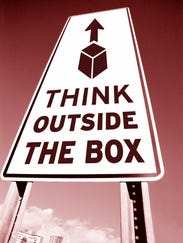If you're a professional "creative," you've likely heard that phrase a thousand times. And it makes you want to scream, "It's hardly like that" — especially these days.
STORY: Creativity is key in current economy
STORY: Retrain brain to fit into new economy
In these times of quarter-to-quarter thinking, reduced budgets and the expectation to "jazz it up," "make it go viral" or "make a logo out of an eagle carrying a vacuum cleaner," the creative industry has grown, well, not so creative.
Many people clamor to get into this line of work, but now 1 in 4 are thinking of quitting.
Take a look at what folks in the industry in the United States and United Kingdom had to say in a new study titled Free the Creative conducted by Getty Images' iStock with KRC Research. The study surveyed more than 400 "creatives" — workers ages 18 to 64 who labor in design or visual arts, production and direction, photography, publishing and advertising or marketing.
The conclusion: The people whose jobs are to be creative are struggling in an increasingly stressful work environment.
Their creativity is under threat from three main barriers: too many responsibilities, lack of time and lack of money.

People in creative fields are told to "think outside the box" but often not given the time to do so.(Photo: Stockbyte, Getty Images)
As a result, nearly one quarter say they spend less than two hours of their day doing "creative work."
The majority — 60% — said they have had great ideas in the past year but not enough time or support at work to achieve what they wanted.
The biggest challenge to working in a creative job is st! aying inspired. Nearly 70% said they want more creative time and 63% said they do not have the time they need for creative reflection and inspiration.
Time constraints make these workers feel stuck in a rut because they have too many competing priorities to just sit and think. Another insight: If these workers feel under the gun, they are less likely than others to take creative risks.
"People spout the mantra, 'Think outside the box.' But doing that, then executing on things outside the box, create risk," a creative director at an advertising agency told me. "And clients and executives don't want to take risks anymore.
"There is no time for creativity, exploring ideas and their consequences in this economy," he said. "Whatever short-term idea can get a business to the next short-term objective reigns."
Technological advances can be good and bad.
“People spout the mantra, 'Think outside the box.' ... (But) clients and executives don't want to take risks anymore.”
— Ad agency creative director"(It) creates more short-term opportunities because it allows us to turn things out overnight," he said. "With that, clients think they can delay decisions until the last minute or that we can just create breakthrough ideas in an hour."
"Truly breakthrough ideas rarely hatch overnight," say the authors of a Harvard Business Review article titled Creativity Under the Gun.
"You may use pressure as a management technique, believing that it will spur people on to great leaps of insight," they say. But is that the best approach? Short answer: no.
"When creativity is under the gun, it usually ends up getting killed." Sure, "time pressure may drive people to work more and get more done, and may even make them feel more creative." But they generally end up thinking less creatively.
The iStock survey also showed that creative thoughts and ideas are born mostly outside the office as people travel to work, take a shower, exercise, listen to m! usic, wat! ch TV or read magazines.
Most of these professionals seek creative channels outside of work in photography, writing or art. Just think of all the creative juice that could come to life if they were free to create at work.
<!--iframe-->
A survey of 400 professionals in creative fields, commissioned by iStock photos, found a lot of frustrations. (Source: iStock by Getty Images)
Career consultant Andrea Kay is the author of This Is How To Get Your Next Job: An Inside Look at What Employers Really Want. Reach her at andrea@andreakay.com. Twitter: @AndreaKayCareer.
No comments:
Post a Comment